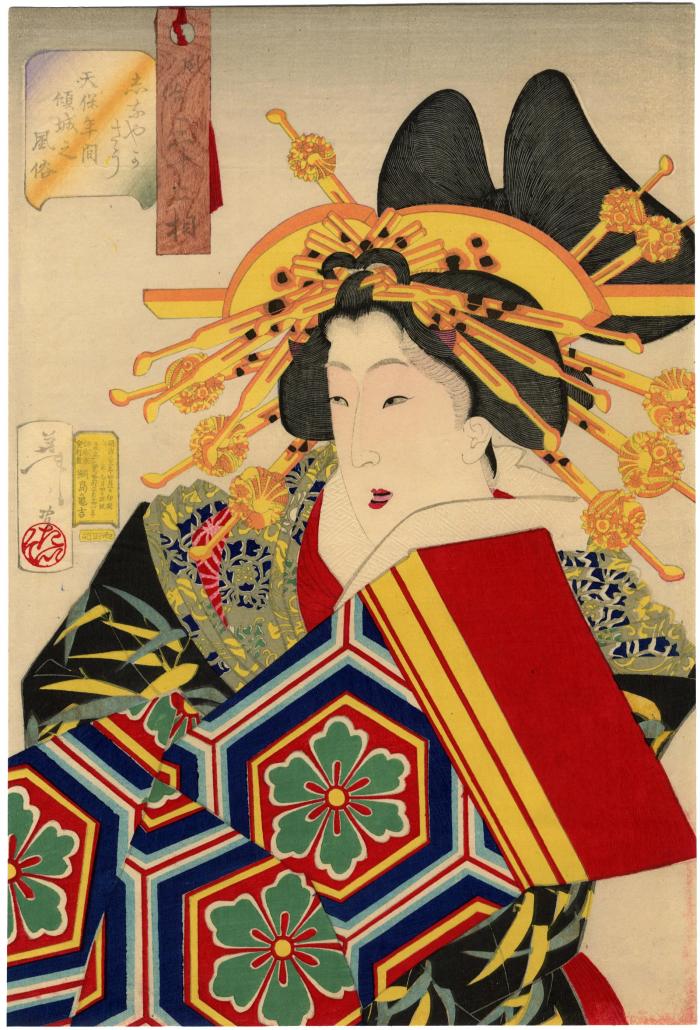Tsukioka Yoshitoshi (月岡芳年) (artist 04/30/1839 – 06/09/1892)
Looking Feminine (Shinayaka-sō - しなやかさう): The Appearance of a 'Castle-toppler' of the Tempo Era (Tempo nenkan keisei no fuzoku - 天保年間: 傾城之風俗), from the series 'Thirty-two Aspects of Customs and Manners' (Fūzoku sanjūni sō - 風俗三十二相)
1888
9.375 in x 13.75 in (Overall dimensions) Japanese woodblock print
Signed: Yoshitoshi ga (芳年画)
Artist's seal: Taiso
Publisher: Tsunashima Kamekichi (綱島亀吉)
Date: Meiji 21, 4th month, 1st day
明治二十一年四月一日
National Diet Library
Edo-Tokyo Museum
Hagi Uragami Museum of Art
Chiba City Museum of Art
Centre Céramique de Maastricht
Ritsumeikan University
National Gallery of Australia
Minneapolis Institute of Art
Lyon Collection - another print from this series: Looking Hot
Lyon Collection - another print from this series: Looking Capable
Lyon Collection - another print from this series: Looking Tiresome "This lady is described as a keisei, 'castle-topper,' a poetic name for a high-ranking courtesan. The term refers to the way rulers can be beguiled by beautiful women to forget the affairs of state, with disastrous results. The most celebrated castle-topper in Chinese and Japanese tradition was Yang Guei-fei (Japanese: Yokihi), whose beauty seduced the Tang emperor Ming Huang in the eighth century. The besotted Ming Huang indulged Yang Guei-fei's every whim, gave influential positions to her relatives and drained the treasury through debauchery, causing an indignant population to rebel and overthrow him.
The rich robes of this castle-topper show her to be very eminent indeed. Yet she does not appear at ease in her finery. Her huge tortoiseshell-patterned obi, tied in front in the manner of a courtesan, is cumbersome and must have severely hampered her movements. (It is almost large enough to qualify for the irreverent epithet obi-gokumon, 'prison-gate sash,' meaning that it is so broad that only the head is visible above it, like that of a decapitated criminal displayed at the gates of a prison.) She wears many layers of heavy brocade robes. Her double-winged hairstyle, echoing the bow of her obi, weighs her down with its collection of gilt and tortoiseshell pins and combs. This style is called yokohyogo and was popular in Shimabara, one of several red-light districts in Kyoto.
The design has been made more luxurious by printing the obi and the bamboo pattern of the outer robe with brass dust to emulate gold thread. This has now darkened with oxidation; the print must have shimmered when first offered to the public. The Tokugawa government periodically passed laws attempting to limit wasteful and conspicuous consumption. Courtesan's clothing was an easy target. After their initial impact had weakened, however, such laws were largely ignored. By the beginning of the Tempo era, when this design was set, courtesans' dress had again become overly ostentatious, and further sumptuary laws were passed in 1841. These affected not only clothing but woodblock prints themselves, which for several years were restricted in terms of subject matter and even the number of colors used.
Despite the heaviness of this design, the description shinayaka of the title has connotations of feminine, sexy, pliant, graceful, gentle, soft, delicate."
Quoted from: Yoshitoshi's Women: The Woodblock Print Series "Fuzoku Sanjiso" by John Stevenson, Avery Press, 1986, page 47. Illustrated by a full-page color reproduction on page 48.
beautiful woman picture (bijin-ga - 美人画) (genre)
Meiji era (明治時代: 1868-1912) (genre)
mitate-e (見立て絵) (genre)
Tsujiokaya Kamekichi (辻岡屋亀吉) (publisher)
